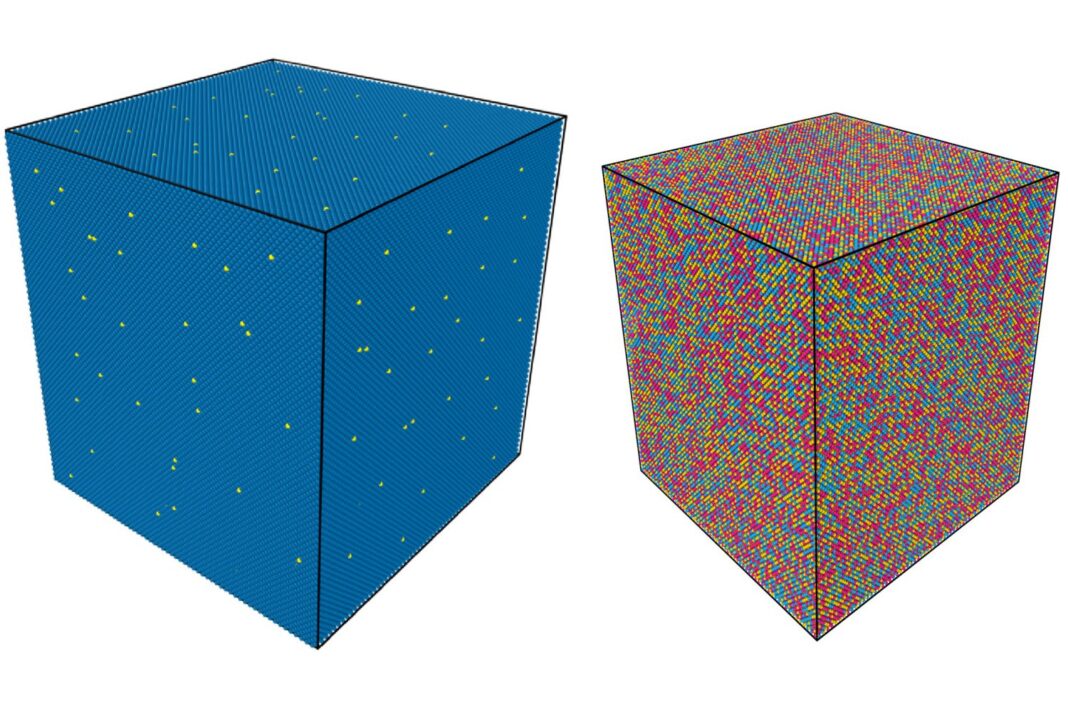In Short:
Two MIT graduate students and their team are using machine learning to quantify the arrangement of atoms in metallic alloys, known as short-range order (SRO). They aim to develop high-performing alloys by understanding how atoms arrange themselves, which is crucial for industries like aerospace and biomedicine. Leveraging machine learning over traditional methods, they are able to identify billions of chemical motifs in high-entropy alloys with unprecedented detail.
The concept of short-range order (SRO) — the arrangement of atoms over small distances — in metallic alloys has been underexplored in materials science and engineering. But the past decade has seen renewed interest in quantifying it, since decoding SRO is a crucial step toward developing tailored high-performing alloys, such as stronger or heat-resistant materials.
Machine Learning to Decode Short-Range Order
Graduate students Killian Sheriff and Yifan Cao from MIT’s Department of Materials Science and Engineering (DMSE) are utilizing machine learning to quantify, atom-by-atom, the complex chemical arrangements that make up SRO. Under the supervision of Assistant Professor Rodrigo Freitas, and with the help of Assistant Professor Tess Smidt in the Department of Electrical Engineering and Computer Science, their work was recently published in The Proceedings of the National Academy of Sciences.
Benefits of Understanding SRO
Interest in understanding SRO is linked to the excitement around advanced materials called high-entropy alloys, whose complex compositions give them superior properties.
Typically, materials scientists develop alloys by using one element as a base and adding small quantities of other elements to enhance specific properties. The addition of chromium to nickel, for example, makes the resulting metal more resistant to corrosion.
Unlike most traditional alloys, high-entropy alloys have several elements, from three up to 20, in nearly equal proportions. This offers a vast design space, making it like making a recipe with a lot more ingredients.
Capturing Short-Range Order
Short-range order refers to the tendency of atoms to form chemical arrangements with specific neighboring atoms. Understanding SRO unlocks the keys to the kingdom of high-entropy materials. Traditional methods for understanding SRO involve small computational models or simulations with a limited number of atoms, providing an incomplete picture of complex material systems.
A Two-Pronged Machine Learning Solution
To study SRO using machine learning, the research team developed a model to accurately quantify SRO and employed 3D Euclidean neural networks to identify chemical motifs from simulations of high-entropy materials with unprecedented detail, examining them atom-by-atom.
Enter the World’s Fastest Supercomputer
Through the U.S. Department of Energy’s INCITE program, the research team will leverage Frontier, the world’s fastest supercomputer, to explore how SRO can change under routine metal processing conditions, like casting and cold-rolling. This will help in engineering alloys with pre-determined SRO.
Future Opportunities in Materials Science
The research aims to uncover mechanisms that metallurgists could employ to engineer alloys with specific SROs, leading to the purposeful design of new classes of materials. The funding for the research was provided by the MathWorks Ignition Fund, MathWorks Engineering Fellowship Fund, and the Portuguese Foundation for International Cooperation in Science, Technology and Higher Education in the MIT–Portugal Program.





